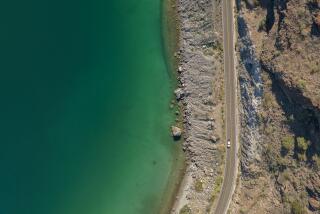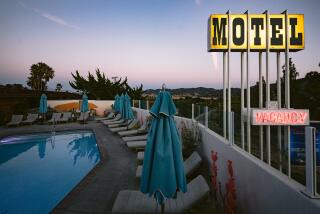A JOURNEY INTO THE HEART OF BASQUE COUNTRY
- Share via
ST. JEAN, France — For the traveler seeking a path to new adventure, the route that unfolds to the Basque countryside is filled with visual joys: Hillsides carpeted with bracken, sheep grazing in verdant valleys and shaggy horses that make this haunting corner of France a joy.--Jerry Hulse, Times Travel Editor
A little train from the old coastal city of Bayonne winds up the wooded valley of the Nive River into the heart of the French Basque country. At the end of the line is St. Jean-Pied-de-Port, which, as its name suggests, sits at the foot of the door to Spain, the pass of Roncevalles in the Atlantic Pyrenees.
Strategic St. Jean was most recently fortified in the 17th Century in the time of Louis XIV. Its narrow cobbled streets are constrained by a crenelated wall of red stones, and a citadel broods over the rooftops. The citadel is used as a high school these days, and sheep graze in its moat.
The lintels over the doors of St. Jean’s houses proudly proclaim who built them and when: “Miguel de Andrenes, 1534,” says one. Like all Basque houses, town or country, these are sturdy, half-timbered construction of stone and whitewashed stucco.
The church’s clock tower is set into the wall and contains a small room that served as the city hall in medieval times. From the gate in the base of the tower a graceful stone bridge arches over the Nive.
The view from the wooded hill above the town is wide. The steep slopes of the surrounding mountains are covered with bracken fern, green in the spring, reddish brown in the autumn. Farmers scythe the fern into tall, conical stacks for fodder or simply burn it, turning the air blue with fragrant smoke.
High above the ridges, hawks cry and immense golden vultures soar on the breeze, eyeing flocks of long-wooled sheep below. Herds of sleek, tan cattle graze beside the shaggy dark ponies called pottoks , horses unchanged in appearance since they were portrayed on the walls of limestone caves in Paleolithic times.
On each side of the wide valley, trim Basque villages squat amid manicured pasture. Each is centered on a church with a clock tower--the custom is to toll the hour twice. In the adjoining graveyards, round discoidal tombstones, reminders of pre-Christian times, often appear among the crosses of iron and marble.
As important to civic life as the church is the free-standing wall of the fronton, or ball court. No sport is more popular among Basques than pelota in its several forms--handball, paddle ball, or the version played with curved wicker baskets known as jai alai on our side of the Atlantic.
Monday is market day in St. Jean, as it has been for centuries. Traveling peddlers sell berets and rope-soled canvas Basque slippers (known elsewhere as espadrilles), traditional items of Basque dress long since adopted by the French.
Parked beneath the dark stone walls are shiny Citroen tractors, and one can find tape cassettes, Dictaphones and other 20th-Century paraphernalia.
But foodstuffs are the main event. Pigs, ducklings and ripe cheese are for sale, and in the fall, fresh-killed wild doves and bulbous garlic, tomatoes and scallions make their appearance. A morning at the market builds a hearty appetite.
One needs that to do justice to a Basque-style lunch or dinner. The impression of Basque cooking formed by a visit to a Basque hotel in America--the kind of heavy, overcooked family-style dinners intended to put life back into half-frozen shepherds fresh off the wintry plains of the Great Basin--could hardly be more different from French Basque cooking, or more misleading.
Savor the piperade aux jambons , a spicy stew of tomatoes and eggs with slices of prosciutto-like local ham, or magret de canard , breast of duck so moist and flavorful that it resembles flank steak more than fowl. Follow up with crisp, sweet pears and brebis des Pyrenees , a piquant sheep’s milk cheese, and finish with a sweet, flaky gateau Basque , rival of the best Parisian pastries.
Irouleguy and Jurancon are among the better-known wines of the countryside, which have delighted travelers since Roman times.
The most prized item on the Basque menu is seasonal, the wild doves thatannually migrate from Northern Europe to Spain in October. The favored way of serving the plump-breasted bird is salmis de palombe , requiring marinating the dark meat in a rich red wine sauce for three days.
Evidence from archeological sites suggests that wild doves have been hunted in much the same way for more than 10,000 years. The key to the hunt is finding the right col, or narrow pass, with a view to the north and wooded slopes on the south side.
As the doves wing through the pass in flocks of a hundred or so, lookouts stationed in tree platforms on either side give the warning cry. At the head of the pass, men flash mirrors or wave white flags or, more traditionally, hurl flat wooden paddles into the air in imitation of attacking falcons.
The doves instinctively dive into the trees to take cover. There, wide nets are strung, 20 or 30 feet above the ground, and some of the fleeing doves fly into the nets, striking the mesh in explosions of gray and white feathers.
In recent times, shotgun-toting hunters have taken to blasting away en masse at doves that escape the nets, but casualties remain light and the great flocks keep flying south.
Favorable hunting locations such as the Col d’Osquich attract hundreds of spectators during the height of the season. Osquich boasts a hotel with view terraces.
West of the mountains the Basque country is bordered by the Bay of Biscay, renowned for its fine-grained sand beaches and elegant summer resorts, infamous for its awesome winter storms.
The Fishing Fleet
Near the border of France and Spain, where the Nivelle River meets the sea, the tiny square harbor of another St. Jean, St. Jean-de-Luz, shelters the Basque fishing fleet. In the handsome 15th-Century church a fine big model of a three-masted whaler is suspended from the ceiling. Where great whaling ships once put to sea, the fishing fleet leaves each November for a six-month pursuit of tuna.
It was in St. Jean’s austere church that the opulent Sun King, Louis XIV, married the Infanta Maria Therese of Spain. Bride and groom lived in separate houses while awaiting the ceremony, Maria in a pink Venetian-style pallazzo facing the harbor, Louis in a miniature chalet on the town square not far away. Both buildings are still in good repair.
The royal wedding set a schizophrenic fashion still followed 300 years later, for the modern St. Jean-de-Luz combines a hard-working fishing port and a resort more charming than its overblown neighbor, Biarritz.
By 6 every morning the fishing boats have unloaded the night’s catch. Restaurant and market owners bid fiercely for tuna and red mullet, eel and squid, flounder and sole. As the sun rises in the river mist, boat crews turn to the endless labor of washing, drying and repairing their nets. The fish markets are opening their doors.
Restaurants and Shops
Superb restaurants cluster on the winding streets between the harbor and the open bay, and sophisticated shops line the Rue Gambetta (no cars allowed) that winds past the church.
Through these towns on the Bay of Biscay chocolate was introduced to Europe. The chocolate factories are long gone, but specialty shops still offer delightful fantasies: chocolate sardines with tinfoil scales, realistic chocolate snails, even whole miniature stage settings with characters molded of chocolate.
The four Spanish Basque provinces are ethnically similar but economically and politically in marked contrast to the three Basque provinces of France. There the dry, rugged Cantabrian Cordillera fronts the Bay of Biscay with pine-covered limestone cliffs; picturesque fishing villages fit into crevices in the rock. But the Basque country of Spain is heavily industrialized, a center of lumbering, mining and manufacture, and the environment has suffered.
Drivers are constantly reminded that many Spanish Basques, unlike their French cousins, have long agitated for separation. Although the road signs are printed in two languages, Basque and Spanish, the Spanish words on almost every sign have been spray-painted black.
In leafy Pamplona, ancient capital of Navarre, politics recedes and the Basque character of the place manifests itself differently. Wherever there are Basques there will be contests, in pelota, wood-chopping, stone-lifting, rowing, or even in tall-tale telling.
Running of the Bulls
In Pamplona, of course, the contest is between men and bulls. Basque or not, anyone can take part in the annual running of the bulls in July, but etiquette suggests a costume of white slacks and shirt and red scarf, unmistakable clue to the custom’s Basque origins.
When bulls and young men are not running through its streets, Pamplona is a sophisticated city of architectural elegance, and wonderful restaurants.
From Pamplona it is a short drive north through the mountains to misty Roncevalles. There in 778 mighty Roland, commanding Charlemagne’s rear guard, met his doom, inspiring the greatest epic of the Middle Ages, the “Chanson de Roland.” Beneath the dripping pines a stone-and-iron monument commemorates his fall.
Near the site stands a new inn in the impeccable Basque tradition, serving much the same functions as the old rambling stone abbey nearby, built to refresh weary pilgrims on their journey to Santiago de Compostella in western Spain. The bones of those who expired in the attempt are buried in a crypt in the pass.
From Roncevalles the road drops steeply into France, past customs inspectors in the villages of Valcarlos and Arneguky who seem surprised that anyone would bother to stop and show a passport. Within a few short kilometers the road returns to St. Jean-Pied-de-Port.
Among these mountain villages, with their stout stone houses and churches, their rolling streams rushing beneath arched bridges, the heart of the Basque country beats strongest.
From Bayonne, a two-car local train serves St. Jean-Pied-de-Port three times a day. The distance is 55 kilometers; the train makes every stop and is an hour en route.
Walkers and bicyclists should equip themselves with the superb walking maps, cartes de randonnees , published by Edition Randonnees Pyreneennes, available in bookstores in Bayonne.
St. Jean-Pied-de-Port is an excellent base for rambling through the western Pyrenees on foot or by bicycle, the most rewarding ways to experience the region.
More to Read
Sign up for The Wild
We’ll help you find the best places to hike, bike and run, as well as the perfect silent spots for meditation and yoga.
You may occasionally receive promotional content from the Los Angeles Times.






